Fiber Optics Solutions
ponedjeljak, 18.05.2015.
SFP Transceiver Signals and Types
Small form-factor pluggable transceiver - Signals
The SFP transceiver holds a Printed track Board that partners with the SFP electronic connector in the service configuration.
Base Transceiver Station
A "base transceiver station" (BTS) is a bit of outfits that eases wireless information exchange amid exploiter out fits (UE) and a network. UEs are implements like protable telephones (handsets), Wireless native loop telephones, computers with wireless Internet connectivity.
The network may be that of whatever of the wireless information exchange applications of tools and methods like GSM, CDMA, wireless native circle, WIFI, WiMAX either different ample zone network (WAN) technics.
BTS is as well referenced to like the broadcast center facility (RBS), point B(in 3G Networks) either, plainly, the center facility (BS). For conversation of the 3GPP Long TERM Evolution normal the shortening EnodeB for developed point B is extensively applied.
Though the expression BTS may be appropriate to whatever of the wireless information exchange norms, it is normally related with portable information exchange applications of tools and methods like GSM and CDMA. In this heed, a BTS forms piece of the center facility self-contained system within larger system (BSS) elaborations for configuration administration. It might as well have outfits for encrypting and decrypting information exchanges, range filtrating implements (band go filters), etcetera. Antenas might as well be deemed like parts of BTS in common feel as they some dissimilar turnaround and dissimilar areas of the cell (in the situation of sectorised center stations). A BTS is managed by a progenitor center facility regulator by way of the center facility command purpose (BCF). The BCF is executed like a separate component either even integrated in a TRX in firm center stations. The BCF delivers a transactions and upkeep (OM) link to the network administration configuration (NMS), and organizes operative states of every one TRX, as well like code managing and alert gathering. The fundamental construction and purposes of the BTS stays the similar notwithstanding of the wireless technologies.
RF module - Transceiver modules
An RF Transceiver component includes either a sender and recipient. The track is characteristically developed aimed at Half-duplex working, though Full twofold components are accessible, characteristically at a developed outlay expected to the appended difficulty.
Small form-factor pluggable transceiver - Types
SFP transmitters and receivers are accessible with a diversity of sender recipient kinds, permitting consumers to choose the suitable transceiver for every one link to supply the needed ocular get to over the accessible ocular fiber sort (e.g. Multi-mode fiber either single-mode fiber). Optical SFP components are normally accessible in some dissimilar categories:
For multi-mode fiber, with black either ecru removal lever
SX - 850nm, for a greatest of 550m at 1.25Gbit/s (Gigabit Ethernet) either 150m at 4.25Gbit/s (Fibre Channel). Related product: 1000BASE SX SFP.
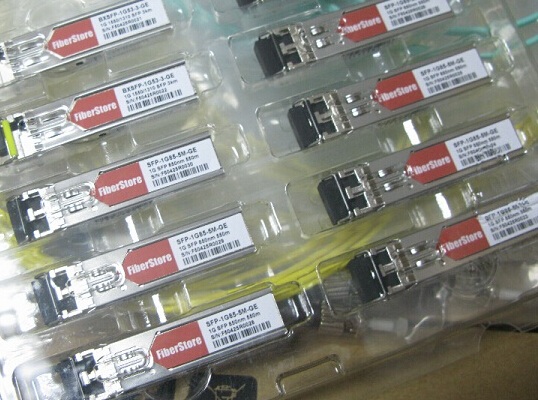
For single-mode fiber, with azure removal lever
- LX - 1310nm, for spaces up to 10km (e.g. Cisco GLC-LX-SM-RGD).
- EX - 1310nm, for spaces up to 40km.
- ZX - 1550nm, for spaces up to 80km.
- EZX - 1550nm, for spaces up to 120km.
- BX - 1490nm/1310nm, Single Fiber Bi-Directional Gigabit SFP Transceivers, matched as "BS-U" and "BS-D" for Uplink and Downlink correspondingly, as well for spaces up to 10km. Variations of bidirectional SFPs are as well produced that employ 1550nm in one management.
- 1550nm 40km (XD), 80km (ZX), 120km (EX either EZX)
- SFSW - Single Fiber Single Wavelength transmitters and receivers, for bi-directional SFPs are a sole fiber. Coupled with CWDM, those duple the flow thickness of fiber ties.
- CWDM and DWDM transmitters and receivers at different wavelengths attaining different greatest distances.
For cuprum twisted couple cabling
1000BASE-T (e.g. GLC-T 1000BASE-T SFP) - those components integrate important circuitry and may solely be applied aimed at Gigabit Ethernet, as that is the user interface they use. They are not harmonious with (or rather: do not have coequals for) Fibre delivery method either SONET.
More related articles about SFP transceiver modules: Optical Transceivers Wiki
Oznake: SFP Transceiver, 1000base-t sfp, GLC-T
petak, 08.05.2015.
Fiberstore 100G CFP and CFP2 Module Solution
Next Generation 100G CFP Modules - CFP2 & CFP4
As 100-Gbps transmission is reaching the field, work is already underway on the second generation of the technology. Upcoming advances will lower costs, increase efficiency, and make 100G applicable to a wider variety of carrier and data center applications. But similar to what has happened in the 10G market, we expect that a different set of optical components will dominate the second and third generation of coherent 100G deployments, where power dissipation, density, and cost are key. Among these optical components, the small form factor pluggable transceiver which supports 100G is one of the essential part, because fiber connectivity in higher-speed active equipment is being condensed and simplified with plug-and-play, hot-swap transceiver miniaturization. And when it comes to providing 100G coherent functionality in a pluggable form factor, CFP and its next generation modules (e.g. 100GBASE-LR4 CFP2) will come to be discussed.
The CFP Multi-Source Agreement (MSA) is currently defining two next generation 100G form factors - CFP2 and CFP4. Compared to the existing CFP form factor, CFP2 and CFP4 will respectively double and quadruple front panel port density. The new form factors take advantage of advances in optics and IC integration, and increase in electrical I/O rate from 10G to 25G. They will support existing and future duplex single-mode fiber (SMF) and parallel multi-mode fiber (MMF) interfaces. The following picture shows the evolution of 100G transceiver modules during 2010 - 2015. Through increasing in front panel density, the next generation of CFP modules will be with a smaller module size and lower power. This is enabled by increased integration of optics and ICs, and by increase in electrical I/O rate from 10G to 25G reducing the I/O width from 10 lanes to 4. In fact, this motivation of immediately taking advantage of advances in integration and I/O technology is similar with the 10G modules.
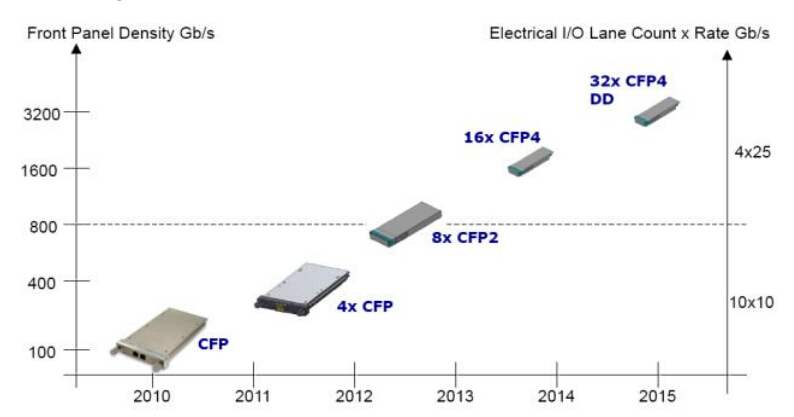
Evolution of 100G CFP during 2010-2015
CFP2 and CFP4 modules are defined to support existing and future SMF applications. The primary application is 100GE-LR4 10km duplex SMF, with CAUI-4 electrical I/O to be defined in. CFP2 will support 100GE-ER4 40km and 100G DWDM optics when integration technology matures. CFP2 and CFP4 can also support the future 100G structured data center 1000m duplex SMF application. In addition, CFP and CFP2 modules support 100GE-SR10 parallel MMF with CAUI interface. CFP2 and CFP4 modules can also support 100GE-SR10 with CAUI-4 electrical I/O by using a 4:10 Gearbox IC. In fact, an extension of the 100GE-SR10 application is break out of the parallel MMF cable into ten duplex MMF fiber pairs to enable high 10GE-SR front panel density. 10x10G electrical I/O can directly support this functionality. However, CAUI-4 electrical I/O does not support this because it breaks up 10GE lanes into 5G Virtual Lanes. To preserve 10GE lanes, the Optical Internetworking Forum (OIF) is defining a Multi Link Gearbox (MLG) standard which will support 10:4 multiplexing and 4:10 de-multiplexing of ten 10GE asynchronous streams across a 4x25G electrical I/O interface. We can see the differences between CFP, CFP2 and CFP4 in the following picture.
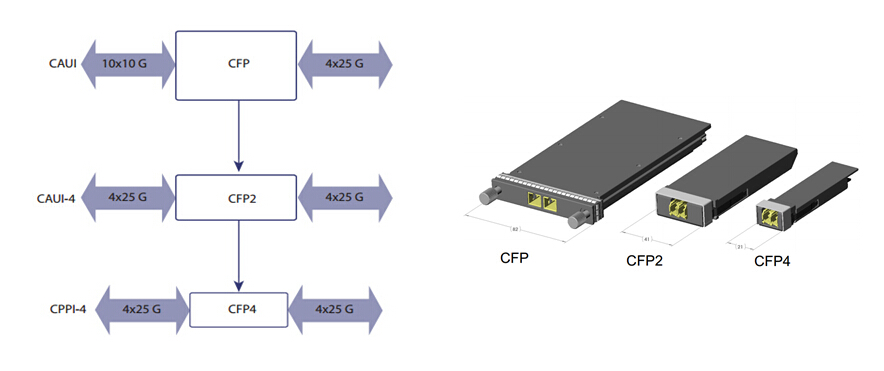
Comparison of CFP, CFP2 and CPF4
Fiberstore Launched the 100G CFP and CFP2 LR4
CFP is widely available in the market, especially with the development of 100G Ethernet in recent years. Fiberstore, the leading manufacturer and supplier of optical communication products, strives to offering the best solution for their customers. Except offering the 100G CFP LR4, they recently announced that they will launch the 100G CFP2 LR4 with high quality and a competitive price. Additionally, it is said that, this CFP2 product can be designed to be compatible with many major brands.
Order Information
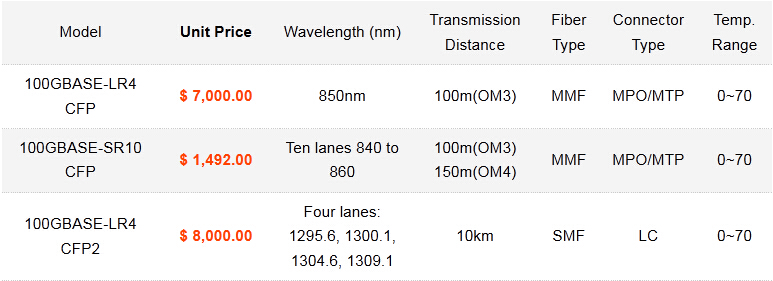
For more information, see: Next Generation 100G CFP Modules – CFP2 & CFP4
Oznake: 100GBASE-LR4 CFP2, 100GBASE-SR10 CFP, 100GBASE-LR4 CFP
utorak, 05.05.2015.
FAQs of SFP modules
Can I use SFP+ optics in SFP ports or use SFP optics in SFP+ ports?
Not all, it's depending on whether the SFP ports accept SFP+ optics (SFP+ 10GBASE Twinax cables and SFP+ modules) or not. However, most (not all) SFP+ ports accept SFP optics. Most 1Gb and 10Gb SFP+ optics only support a single speed (e.g. 10Gb optics can't run at 1Gb). As long as you have a 1Gb SFP at both ends you shouldn't have a problem.
The Summarize of SFP Module
The structure of SFP optical module are: laser, including transmitter and receiver, external fittings are: base, shell, PCBA, unlock pieces, TAB, card buckle, rubber plug, the other to help you identify the convenient, general using the color of the TAB to recognize the parameters of the module type.
According to the rate divided 155M/622M/1.25G/2.125G/4.25G/8G/10G, 155M and 1.25G currently available on the market use more, 10G technologies are maturing, demand positive attitude to rise development is the next major optical module products.
According to the wavelength divided 850nm/1310nm/1550nm/1490nm/1530nm/1610nm, as SFP 850nm wavelength multimode transmission distance 2km less frequent like Cisco GLC-SX-MM; 1310/1550nm wavelength for Single-mode, the transmission distance 2KM above, relatively speaking, these 3 wavelengths lower cost compared to the other.
If you can't know the bare module is simple to confuse the normal distinction between manufacturers will pull rings in color, take CWDM SFP module as an example: black pull ring for multimode wavelength is 850nm; blue wavelength 1310nm module; yellow is the wavelength of 1550nm module; purple is the wavelength of 1490nm module.
Why choose compatible SFP Module
The simple answer to this query (as most other suppliers will explain) is cost, but that's just one of the reasons to purchase a compatible SFP, SFP+ or XFP fiber optic transceiver. For example in a scenario where gigabit speed is required to run across a point-to-point link, the distance between the link length is assessed and an appropriate SFP transceiver module native to the host device is chosen. If a Cisco platform was in situ then the selection of module will be limited by among the following: 550meter (GLC-SX-MMD), 10km (GLC-LH-SMD), 40km (GLC-EX-SMD) or the maximum 70km (GLC-ZX-SMD). Using a compatible SFP you can choose from a variety of distance limits from 550meters up to 100km in numerous increments with distances of 160km being achievable on the top product lines.
Another advantage of use compatible SFP transceivers is the freedom to tailor the transceiver to your individual requirement.
- Custom serial numbers can be added both to the product label and also hard coded to the device itself.
- Customer Logos can be added to the products.
Latches can be color coded for high density link identification Fiberstore also provide a recoding service in China, this specific service means existing SFP's can be adapted if the host device is to be changed. In some instances, even cross-device compatibility is quite possible.
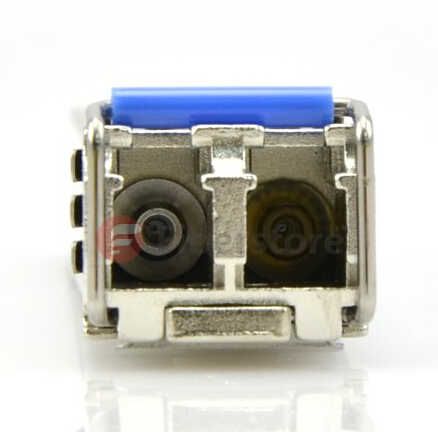
SFP transceiver is a very popular format that’s recommended by a large number of fiber optic component providers. These businesses carry SFP transceivers for those Cisco and HP devices along with transceiver modules for many other manufacturers. Especially, you can find a full product line of our New HP SFP modules, such as J4858C, J4859C, JD118B, and JD092B, etc. Our HP SFP and SFP+ moduels are 100% compatible with a good price and enjoy same-day shipping.
Oznake: SFP module, SFP Transceiver, HP J4859C, Cisco SFP
| < | svibanj, 2015 | > | ||||
| P | U | S | Č | P | S | N |
| 1 | 2 | 3 | ||||
| 4 | 5 | 6 | 7 | 8 | 9 | 10 |
| 11 | 12 | 13 | 14 | 15 | 16 | 17 |
| 18 | 19 | 20 | 21 | 22 | 23 | 24 |
| 25 | 26 | 27 | 28 | 29 | 30 | 31 |
Srpanj 2015 (1)
Lipanj 2015 (4)
Svibanj 2015 (3)
Travanj 2015 (13)
Ožujak 2015 (10)
Veljača 2015 (8)
Siječanj 2015 (9)
Prosinac 2014 (4)
Dnevnik.hr
Gol.hr
Zadovoljna.hr
Novaplus.hr
NovaTV.hr
DomaTV.hr
Mojamini.tv
About Me
Ima Blogger, Just Share Various Fiber Optic Telecom Network Topics, Information, News, Questions, Sources and Network Solutions.
